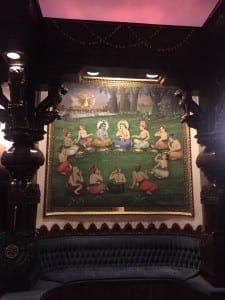Krishna of Kalachandji
Just a short drive from Southern Methodist, I found myself in an unknown part of the city, much different than the distinctly homogeneous Highland Park that I call home. This is where my first experience with the religion of Hare Krishna took place, and I had somewhat skeptical expectations, since the only thing I knew about this field-trip was that we would be learning about an Indian religion from a “weird white guy.” I knew Hare Krishna was popular with some of our more eccentric celebrities, so I thought maybe it would be a bizarre religion like Scientology.
Upon walking into the temple, I was quite amazed by the elaborate paintings, ceiling sculptures, and a very intricate, bright shrine. We were met by a devotee in his religious garments, with a tattoo in a language that might have been Sanskrit (I’m not yet a master of the ancient language, so I can’t say for sure). He introduced us to the texts of his religion, written in the 1960s by their founder, Prabhupad, such as his translation of the Bhagavata Purana. He talked about the religion in a somewhat abstract way, mentioning many pseudoscientific facts. He showed us his favorite painting in the room, which depicted young Krishna eating with his friends, painted by B.G. Sharma in the 1980s. I was curious about the story of the painting, and although our guide explained it to us, there were many times he jumped from one scene to another without connection and I was mostly confused through the whole explication. However, what I got from it is that Krishna is god but has a form like we do, and that we should have a parental relationship with him. Each piece of art told a story about Krishna, and gave him a personality. There was a painting of him dancing, to show his omniscient and intimate presence, and another of him holding up a mountain with the nail of his pinky finger, sheltering the townspeople from a deadly rain. There were other paintings in which he was depicted as a child, without the saintly halo, doing such things as sneaking into the neighbor’s house. It seems to me that devotees of Hare Krishna are attracted to the religion partly because they feel as if they know Krishna personally, and because he accepts people of all race, class, and gender.
During our tour, a man in a white robe knelt in front of the shrine and rang a bell and spoke in a language unknown to me as he offered the deity his lunch. Our guide said that devotees offer food to Krishna as an expression of love. Just like we cook and sing for a child, they cook and sing for their god. What is especially parental about their behavior is that everyday, twice a day, forty priests change the deity’s clothing and surroundings, including flowers, incense, and other decorations. Devotees of Hare Krishna participated in these activities so that they could be seen and blessed by Krishna, called Darshan, and that even small actions of love were appreciated. While the tour was fascinating, I still find the religion somewhat peculiar. But what could I have expected of a faith started in the sixties by an old, chanting Indian man.


